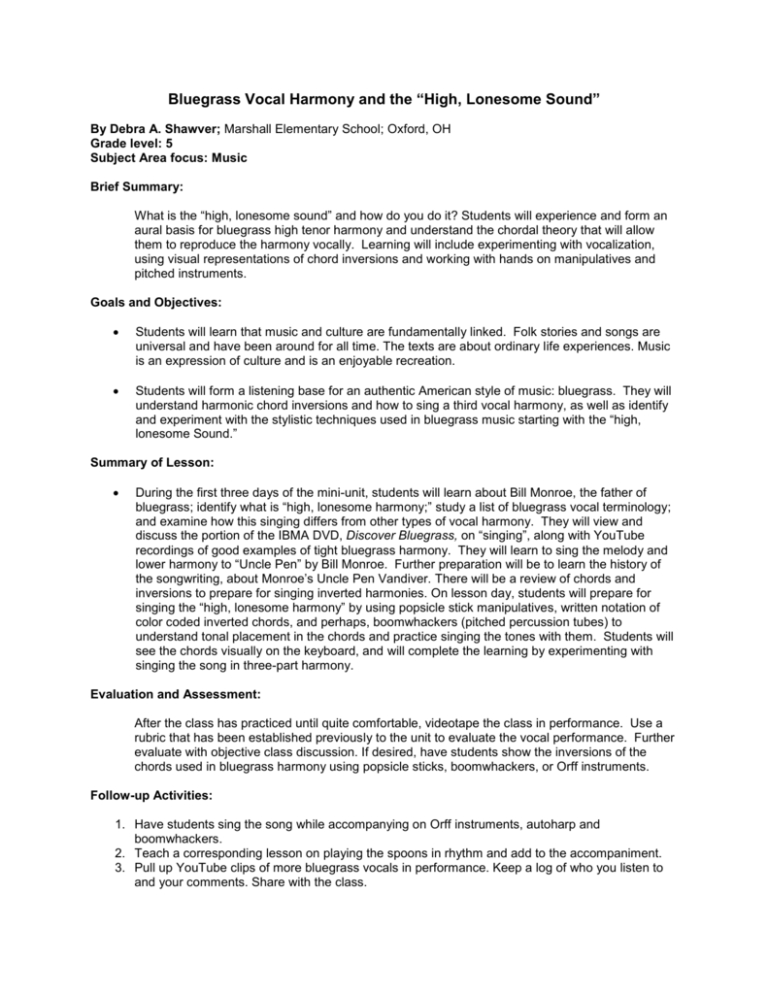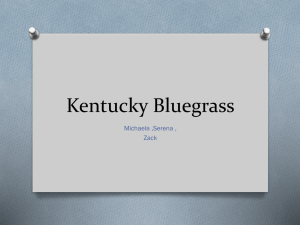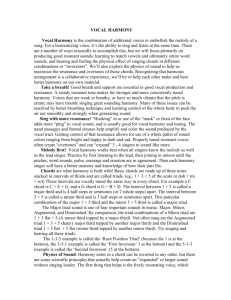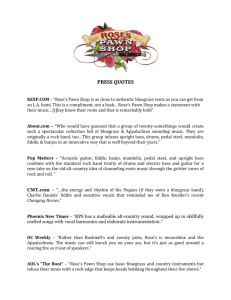
Bluegrass Vocal Harmony and the “High, Lonesome Sound”
By Debra A. Shawver; Marshall Elementary School; Oxford, OH
Grade level: 5
Subject Area focus: Music
Brief Summary:
What is the “high, lonesome sound” and how do you do it? Students will experience and form an
aural basis for bluegrass high tenor harmony and understand the chordal theory that will allow
them to reproduce the harmony vocally. Learning will include experimenting with vocalization,
using visual representations of chord inversions and working with hands on manipulatives and
pitched instruments.
Goals and Objectives:
Students will learn that music and culture are fundamentally linked. Folk stories and songs are
universal and have been around for all time. The texts are about ordinary life experiences. Music
is an expression of culture and is an enjoyable recreation.
Students will form a listening base for an authentic American style of music: bluegrass. They will
understand harmonic chord inversions and how to sing a third vocal harmony, as well as identify
and experiment with the stylistic techniques used in bluegrass music starting with the “high,
lonesome Sound.”
Summary of Lesson:
During the first three days of the mini-unit, students will learn about Bill Monroe, the father of
bluegrass; identify what is “high, lonesome harmony;” study a list of bluegrass vocal terminology;
and examine how this singing differs from other types of vocal harmony. They will view and
discuss the portion of the IBMA DVD, Discover Bluegrass, on “singing”, along with YouTube
recordings of good examples of tight bluegrass harmony. They will learn to sing the melody and
lower harmony to “Uncle Pen” by Bill Monroe. Further preparation will be to learn the history of
the songwriting, about Monroe’s Uncle Pen Vandiver. There will be a review of chords and
inversions to prepare for singing inverted harmonies. On lesson day, students will prepare for
singing the “high, lonesome harmony” by using popsicle stick manipulatives, written notation of
color coded inverted chords, and perhaps, boomwhackers (pitched percussion tubes) to
understand tonal placement in the chords and practice singing the tones with them. Students will
see the chords visually on the keyboard, and will complete the learning by experimenting with
singing the song in three-part harmony.
Evaluation and Assessment:
After the class has practiced until quite comfortable, videotape the class in performance. Use a
rubric that has been established previously to the unit to evaluate the vocal performance. Further
evaluate with objective class discussion. If desired, have students show the inversions of the
chords used in bluegrass harmony using popsicle sticks, boomwhackers, or Orff instruments.
Follow-up Activities:
1. Have students sing the song while accompanying on Orff instruments, autoharp and
boomwhackers.
2. Teach a corresponding lesson on playing the spoons in rhythm and add to the accompaniment.
3. Pull up YouTube clips of more bluegrass vocals in performance. Keep a log of who you listen to
and your comments. Share with the class.
Additional Information (including national and/or state requirements or standards addressed):
National Standards in Music:
Standard 1 – Singing, alone and with others, a varied repertoire of music.
Standard 3 – Improvising melodies, variations and accompaniments.
Standard 5 – Reading and notating music.
Standard 6 – Listening to, analyzing and describing music.
Standard 7 – Evaluating music and music performances.
Standard 9 – Understanding music in relation to history and culture.
Resources Used:
Audio Resources
Recordings-20th Century Masters- The Millennium Collection: The Best of Bill Monroe, “Uncle Pen,” “Mule
Skinner Blues,” Geffen Records, 1999.
“Uncle Pen” Spotlight on Music Grade 5, CD 2:2
Music-“Uncle Pen,” Words and Music by Bill Monroe. Copyright @ 1951 by Unichappell Music, Inc.
Copyright Renewed. International Copyright. All Rights Reserved.
Visual Resources
Discover Bluegrass: Exploring American Roots Music: DVD, IBMA, Nashville, Tenn., 2005.
Shawver’s hand written notation that is an example of the harmonization of the song in three-part
harmony based on chord inversions.
Written notation of chord inversions in key of G.
Keyboard diagram (I used the one in the back of the grade five Spotlight on Music text [citation
below]).
Bluegrass vocal vocabulary terms.
Spotlight on Music, Macmillan/McGraw Hill Education, a division of The McGraw Hill Companies,
Inc., Two Penn Plaza, New York, New York 10121, 2005.
Internet Resources
“Uncle Pen”-Bill Monroe: http://www.youtube.com/watch?v=r2XT9u7iw9o
“Fishers of Men”-Rhonda Vincent: http://www.youtube.com/watch?v=T9RXHwYU2JY
“When I Get Home”-Ralph Stanley and the Clinch Mountain Boys:
http://www.youtube.com/watch?v=F1nxUFljfww
“Down in the Valley to Pray”-Alison Krauss, Doc Watson, and Ricky Skaggs:
http://www.youtube.com/watch?v=WRGxbFmlni4&feature=related
“Go to Sleep Little Baby” from O’ Brother Where Art Thou?-Alison Krauss, Emmylou Harris, and
Gillian Welch: http://www.youtube.com/watch?v=SjVZB34ibNo
Lesson Plan Outline: Bluegrass Vocal Harmony & the “High, Lonesome Sound.”
Objectives:
After completing this lesson, students will be able to do the following:
Identify chord inversions
Describe what the “high, lonesome sound” means in bluegrass music
Sing (to their best effort) a high harmony in a bluegrass song
Recognize characteristic bluegrass stylistic vocalizations
Recognize how bluegrass music reflects folk culture
Materials used:
IBMA DVD (Discover Bluegrass)
Recordings:
~Bill Monroe-“Uncle Pen”
~Spotlight on Music Macmillan McGraw Hill Volume 5 CD 2:1-5; Text for teacher and
students: fifth grade pp. 22-25
~Bill Monroe-“Mule Skinner Blues” (as time allows)
CD Player, computer and projector/DVD player
Boomwhackers in the G major scale
Board with staff and dry erase markers or chalk
Keyboard or Orff barred instruments
Plain popsicle sticks (8 per student) and markers
Three colors of popsicle sticks to make chord inversions
Student Handouts: keyboard diagram, staff with chords and inversions, vocabulary sheets
Copies of the song: “Uncle Pen” by Bill Monroe
YouTube Clips (with technology to project from Internet inn the Classroom)
~“Uncle Pen”-Bill Monroe: http://www.youtube.com/watch?v=r2XT9u7iw9o
~“Fishers of Men”-Rhonda Vincent:
http://www.youtube.com/watch?v=T9RXHwYU2JY
~“When I Get Home”-Ralph Stanley and the Clinch Mountain Boys:
http://www.youtube.com/watch?v=F1nxUFljfww
~“Down in the Valley to Pray”-Alison Krauss, Doc Watson, and Ricky Skaggs:
http://www.youtube.com/watch?v=WRGxbFmlni4&feature=related
~“Go to Sleep Little Baby” from O’ Brother Where Art Thou?-Alison Krauss, Emmylou
Harris, and Gillian Welch: http://www.youtube.com/watch?v=SjVZB34ibNo
Video camera and rubrics for evaluation
Prior Knowledge and Experience/Curriculum Content:
Aural and visual recognition of major scale; understanding of musical phrases, chord structure in
root position; experience listening and identifying chordal harmonic changes; extensive vocal
experience in melody and harmony of at least two parts; ability to play chords on Orff instruments
and boomwhackers; introductions to bluegrass music, including: history (including IBMA DVD),
connecting immigrations from British Isles and musical influence to Appalachian mountain music,
“old time music” to 1940s plus bluegrass music; instrumentation of bluegrass music and stylistic
elements (such as blues harmonic progression and vocal stylings); multiple listening experiences
to instrumental, vocal/instrumental and a cappella bluegrass music; introduce and give biography
of Bill Monroe, “the father of bluegrass” and note that he was the master of bluegrass “high,
lonesome” harmony.
Procedure:
1. Review previous day’s learning by listening to “Uncle Pen” by Bill Monroe another time. Practice
song as learned previous day.
2. Distribute staff paper handouts of chordal inversions. Look at chords on board and papers, and
demonstrate visually and aurally how the chord can change by moving the positions of the three
notes per chord.
3. Distribute 8 popsicle sticks and one marker per child. Have students label their popsicle sticks: G
A B C D E F# G
4. Ask students to build a ROOT position G chord, and then check each other’s work. Then, build a
first inversion chord and check. Repeat process for second inversion.
5. Look at keyboard diagram, popsicle sticks and compare to Boomwhackers arranged in a G Major
Scale. Ask student volunteers to construct and play the G chord in root position, then in first and
second inversions.
6. Use each of the three colors of colored popsicle sticks to form root and inversion chords.
7. Divide class into three groups, according to popsicle stick colors. Have one group sing the G
pitch, another group the B pitch and a third the D pitch. Practice the inversions. Good luck!
*Music Teacher Note: It is possible that there could be students who naturally “hear” the tenor
part if they have had choral, church, or family background. You could experiment by allowing
them to try to sing a third part before you attempt to teach the third harmony. Due to the high
tessitura of the vocal range, since it is written in a key appropriate for children, you may want to
invite students to participate in that part (adults can sing it down the octave).
8. Look at where the third, “high, lonesome” tenor part could sit in the score. Highlight that one of
the earmarks of the high, lonesome sound is a drone, and it often sits at an interval of a 4th or
more often, a 5th away from the melody.
9. Teach the tenor part by echoing the harmonic phrases.
10. Try the three parts together! You could allow students to play the boomwhackers on the G chords
to help them keep a tonal “anchor.” Cross your fingers and pray!
11. Have fun singing the whole song with high, lonesome harmony with the accompaniment on CD!
12. If time remains, or in the following lesson, listen to Bill Monroe sing “Mule Skinner Blues” and
watch more of the YouTube segments. Identify scoops, slides, turns, fall offs and other vocal
effects, including “whooping and hollering!”
13. Practice!
Indicators of Success:
Students will-- Express enjoyment of the singing experience.
Describe “high, lonesome sound.”
Arrange popsicle sticks or boomwhackers into second and third inversion chords.
Supplementary Information:
Scanned notation of example of “Uncle Pen” three part vocal harmony
Bluegrass vocal vocabulary terms
Keyboard diagram (I used the one in the back of the Spotlight on Music G. 5 book)
Attachments:
Vocabulary for Bluegrass Vocal Harmony
Melody - the tune of the song
Accompaniment - the background music that sounds nicely with the melody (enhancing the melody); is
usually chordal and on instruments
Harmony - extra vocal or instrumental strands of music that sound well alongside the tune; usually
chordal
Lead - the vocal melody
Tenor - the highest vocal part in bluegrass; often the 3rd of the chord; the highest male vocal range in
classical training
Baritone – usually the lowest vocal part in bluegrass (unless there is a bass part—for example, in gospel
quartets); often the 5th of the chord; the medium and most common male vocal range in classical
training
Stack - a bluegrass term for the notes of the chord in order, sung at one time; in classical music theory it
is called a “block chord”
Vocal ornamentation/decorations/embellishments (such as: sixteenth notes, grace notes, “bend,”
glissando, fall-off, scoop, slide, slurs) - techniques used in various musical styles to move or flex
the voice away from the melodic line to enhance the text
“High, lonesome sound” - a bluegrass term indicating a high tenor voice with nasal quality; often sung in a
“driving” style with a cutting-edge tone at the top of a singer’s vocal range
Consonant - chordal harmony in which the tones seem to belong together
Dissonant - harmony that sounds as if the tones do not belong together; they “clash”
Modal - based on the ancient modes used in music from the British Isles folk music (such as a bagpipe)
and employed in the folk music of Appalachia
Chord - two or more pitches sounding together or one after the other (block and broken chords)
Root position chords - tones in this order: root or first note of the scale, the third tone of the scale and the
fifth note of the scale
First inversion - the notes of the root chord, turned around so the root is on top of the chord
Second inversion - the notes of the root chord, turned around so the 3rd of the chord is on top of the chord
Close harmony - vocal harmony that contains harmonic parts sitting near each other on the music
staff/musical scale; chordal harmony
Nasal - vocalization that resonates in the nasal cavities
A cappella - singing without instrumental accompaniment







